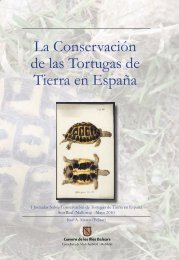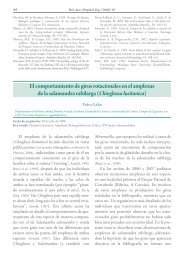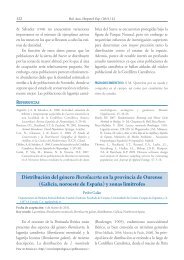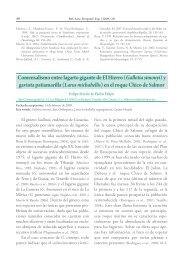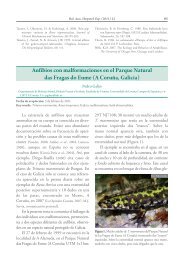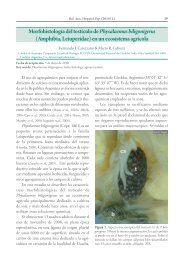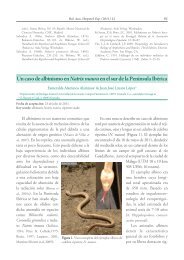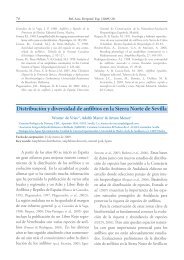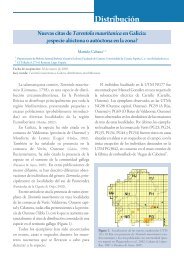The karyotype of Sceloporus macdougallii (Squamata ...
The karyotype of Sceloporus macdougallii (Squamata ...
The karyotype of Sceloporus macdougallii (Squamata ...
You also want an ePaper? Increase the reach of your titles
YUMPU automatically turns print PDFs into web optimized ePapers that Google loves.
Rev. Esp. Herp. (2004) 18:75-78<br />
<strong>The</strong> <strong>karyotype</strong> <strong>of</strong> <strong>Sceloporus</strong> <strong>macdougallii</strong><br />
(<strong>Squamata</strong>: Phrynosomatidae)<br />
FERNANDO MENDOZA-QUIJANO 1 & IRENE GOYENECHEA 2<br />
1 Instituto Tecnológico Agropecuario de Hidalgo, Apartado Postal 94, Carretera Huejutla-<br />
Chalahuiyapa km 5.5, Huejutla de Reyes, Hidalgo, México, C.P. 43000<br />
2 Centro de Investigaciones Biológicas, Universidad Autónoma del Estado de Hidalgo,<br />
Apartado Postal 1-69 Plaza Juárez Pachuca, Hidalgo, México C.P. 42000<br />
(e-mail: ireneg@uaeh.edu.mx)<br />
Abstract: We report the <strong>karyotype</strong> <strong>of</strong> <strong>Sceloporus</strong> <strong>macdougallii</strong>, a lizard endemic to the state <strong>of</strong> Oaxaca,<br />
Mexico, member <strong>of</strong> the torquatus group. <strong>The</strong> results confirm a constant chromosomal number for<br />
members <strong>of</strong> the torquatus group within <strong>Sceloporus</strong>, which is 2n = 32 for females and 2n = 31 for males.<br />
This <strong>karyotype</strong> may be fixed in the “crevice-user” groups <strong>of</strong> <strong>Sceloporus</strong> but there are three remaining<br />
species in the torquatus group that need to be <strong>karyotype</strong>d for confirmation.<br />
Key words: <strong>karyotype</strong>, Oaxaca, Phrynosomatidae, <strong>Sceloporus</strong> <strong>macdougallii</strong>.<br />
Resumen: El cariotipo de <strong>Sceloporus</strong> <strong>macdougallii</strong> (<strong>Squamata</strong>: Phrynosomatidae). – Se presenta el<br />
cariotipo de <strong>Sceloporus</strong> <strong>macdougallii</strong>, lagartija endémica del estado de Oaxaca, México que pertenece al<br />
grupo torquatus. Los resultados obtenidos confirman un número cromosómico constante para el grupo<br />
torquatus dentro de <strong>Sceloporus</strong>, que es 2n = 32 para hembras y 2n = 31 para machos. Este cariotipo<br />
parece estar fijado en los grupos de <strong>Sceloporus</strong> que utilizan grietas, sin embargo hace falta analizar el<br />
cariotipo de otras tres especies del grupo.<br />
Palabras clave: cariotipo, Oaxaca, Phrynosomatidae, <strong>Sceloporus</strong> <strong>macdougallii</strong>.<br />
INTRODUCTION<br />
<strong>Sceloporus</strong> <strong>macdougallii</strong> is restricted to the<br />
state <strong>of</strong> Oaxaca México and is hypothesized<br />
to be a member <strong>of</strong> the torquatus group<br />
(SMITH, 1939; HALL, 1973; SITES et al., 1992;<br />
WIENS & REEDER, 1997). SITES et al. (1992)<br />
reviewed chromosome data for the entire<br />
genus and, summarizing HALL (1973),<br />
suggested that this group consisted <strong>of</strong> 13<br />
species distributed throughout most <strong>of</strong><br />
Mexico, across mid- to high-elevation<br />
environments, north <strong>of</strong> the isthmus <strong>of</strong><br />
Tehuantepec, and includes the following<br />
species: <strong>Sceloporus</strong> bulleri, S. cyanogenys,<br />
S. dugesii, S. insignis, S. jarrovii, S.<br />
lineolateralis, S. <strong>macdougallii</strong>, S. mucronatus,<br />
S. ornatus, S. poinsettii, S. prezygus, S. serrifer,<br />
and S. torquatus. <strong>The</strong> monophyly <strong>of</strong> this<br />
group has been confirmed by WIENS &<br />
REEDER (1997), but recent molecular studies<br />
<strong>of</strong> <strong>Sceloporus</strong> jarrovii (WIENS et al., 1999)<br />
suggest that current names may misrepresent<br />
the biodiversity <strong>of</strong> this group and that the<br />
total number <strong>of</strong> species may be higher.<br />
All known <strong>karyotype</strong>s in the torquatus<br />
group are constant: 2n = 31 in males and 2n =<br />
32 in females, and the difference between the<br />
sexes is likely due to the presence <strong>of</strong> a<br />
X 1<br />
X 1<br />
X 2<br />
X 2<br />
F / X 1<br />
X 2<br />
YM sex chromosome heteromorphism<br />
identical to that originally<br />
described by COLE et al. (1967). This 2n =<br />
32/31 <strong>karyotype</strong> is shared by three other<br />
species groups (i.e. asper, megalepidurus and<br />
grammicus), that together with the torquatus<br />
group are referred to as the “crevice
76<br />
F. MENDOZA-QUIJANO & I. GOYENECHEA<br />
dwelling” clade (HALL, 1973; SITES et al.,<br />
1992).<br />
SMITH’s (1939) monograph on <strong>Sceloporus</strong><br />
predated the description <strong>of</strong> S. <strong>macdougallii</strong>,<br />
and therefore did not include this species in<br />
the torquatus group. Moreover, this species<br />
was not available for the analyses <strong>of</strong> LARSEN<br />
& TANNER (1974, 1975), who reviewed the<br />
genus. Nevertheless, these authors included<br />
the species in the torquatus group with bulleri,<br />
S. cyanogenys, S. insignis, S. mucronatus, S.<br />
poinsetti, S. serrifer and S. torquatus. In a<br />
summary <strong>of</strong> the chromosomal data <strong>of</strong><br />
<strong>Sceloporus</strong>, SITES et al. (1992; their Table 4)<br />
indicated the uncertain status <strong>of</strong> some species<br />
in the torquatus group, owing to the<br />
undetermined chromosome number for four<br />
species for which karyotypic data are lacking:<br />
S. insignis, S. lineolateralis, S. <strong>macdougallii</strong>,<br />
and S. prezygus. No further genus-wide<br />
studies on <strong>karyotype</strong>s for <strong>Sceloporus</strong> have<br />
been published, although the <strong>karyotype</strong> <strong>of</strong> one<br />
additional species, S. smaragdinus, has been<br />
recently described (GOYENECHEA &<br />
MENDOZA-QUIJANO, 1993). Here we describe<br />
the <strong>karyotype</strong> <strong>of</strong> S. <strong>macdougallii</strong> to determine<br />
whether it conforms to the constant<br />
chromosome number observed to date in the<br />
torquatus group.<br />
and transported to the laboratory, where they<br />
were processed for mitotic <strong>karyotype</strong>s as<br />
described by PORTER & SITES (1985).<br />
Chromosomes were prepared from femoral<br />
bone marrow and studied as described for<br />
other phrynosomatid lizards (COLE, 1978;<br />
SITES, 1983). Chromosome preparations were<br />
stained with standard techniques using 5%<br />
Giemsa. Specimens were deposited in the<br />
herpetological collection <strong>of</strong> the Centro de<br />
Investigaciones Biológicas (CIB), Universidad<br />
Autónoma del Estado de Hidalgo (CIB<br />
385-388).<br />
RESULTS<br />
We examined chromosomes <strong>of</strong> five mitotic<br />
cells from each <strong>of</strong> the four specimens <strong>of</strong> S.<br />
<strong>macdougallii</strong>, and recorded a total <strong>of</strong> 20<br />
cells in mitotic phase. Both females had a<br />
diploid number <strong>of</strong> 2n = 32 chromosomes,<br />
and both males had a diploid number <strong>of</strong> 2n =<br />
31 (Figs. 1, 2), with 12 macro chromosomes<br />
(10 metacentrics and 2 submetacentrics) and<br />
20 (female) or 19 (male) micro<br />
chromosomes.<br />
MATERIALS AND METHODS<br />
Two adult males (CIB 385, 386) and two adult<br />
females (CIB 387, 388) <strong>of</strong> S. <strong>macdougallii</strong><br />
were collected on 9 January 2002 at km 75 on<br />
highway 200, Salina Cruz-Huatulco, ca. 1 km<br />
S <strong>of</strong> the junction to Santa Cruz, Bamba,<br />
Oaxaca (16° 01’ 18” N, 95° 26’ 03” W), at an<br />
elevation <strong>of</strong> 100 m. <strong>The</strong> vegetation is<br />
characterized as tropical dry forest<br />
(RZEDOWSKI, 1978), with low trees and<br />
columnar cacti.<br />
All lizards were captured alive by noose,<br />
FIGURE 1. Metaphase cell <strong>of</strong> <strong>Sceloporus</strong> <strong>macdougallii</strong>,<br />
male (CIB 385), photographed at 100x.<br />
FIGURA 1. Célula en metafase de un macho de <strong>Sceloporus</strong><br />
<strong>macdougallii</strong> (CIB 385), fotografiada a 100x.
KARYOTYPE OF <strong>Sceloporus</strong> <strong>macdougallii</strong> 77<br />
S. insignis, S. lineolateralis and S. prezygus,<br />
need to be <strong>karyotype</strong>d for confirmation.<br />
Acknowledgments<br />
FIGURE 2. Karyotype <strong>of</strong> <strong>Sceloporus</strong> <strong>macdougallii</strong> (CIB<br />
385) 2n = 31 (10MM, 2SMM, 16m, X 1<br />
X 2<br />
Y) showing 12<br />
macro chromosomes and 19 micro chromosomes.<br />
FIGURA 2. Cariotipo de <strong>Sceloporus</strong> <strong>macdougallii</strong> (CIB 385)<br />
2n = 31 (10MM, 2SMM, 16m, X1X2Y). Se observan 12<br />
macro-cromosomas y 19 micro-cromosomas.<br />
DISCUSSION<br />
<strong>The</strong> <strong>karyotype</strong> observed in the four lizards is<br />
typical <strong>of</strong> the <strong>Sceloporus</strong> torquatus group,<br />
and is consistent with all other groups <strong>of</strong> the<br />
“crevice dwellers“ previously reported (e.g.<br />
<strong>Sceloporus</strong> bulleri, S. cyanogenys, S. dugesii,<br />
S. jarrovii, S. mucronatus, S. ornatus, S.<br />
poinsettii, S. serrifer, and S. torquatus; SITES<br />
et al., 1992). It differs from the standard<br />
<strong>Sceloporus</strong> <strong>karyotype</strong> (2n = 34; 12M + 22m)<br />
by the absence <strong>of</strong> one pair <strong>of</strong> micro<br />
chromosomes, and from the hypothesized<br />
ancestral <strong>karyotype</strong> for the Iguania (2n = 36;<br />
12M + 24m) by the absence <strong>of</strong> two pairs <strong>of</strong><br />
micro chromosomes (GORMAN, 1973). <strong>The</strong><br />
staining technique used here did not permit us<br />
to corroborate the sex chromosome<br />
heteromorphism found by HALL (1977;<br />
summarized by SITES et al., 1992); C-banding<br />
or meiotic pairing data might be needed to<br />
confirm this heteromorphism in S.<br />
<strong>macdougallii</strong>, but the 2n is consistent with<br />
such expectations.<br />
<strong>The</strong>se results confirm that species in the<br />
torquatus group are identical karyotypically,<br />
and that this condition may be fixed in the<br />
crevice-user clade. <strong>The</strong> three remaining<br />
recognized species in the torquatus group:<br />
Financial support was provided by<br />
FOMES 1999, 2000, and 2001, PAU 2003<br />
and 2004 to I. Goyenechea and by DGETA<br />
(project 047.2001-UR600PY44) to F.<br />
Mendoza. M. Hernandez Bautista, M.<br />
Hernández Aquino and A.A. Valencia<br />
Hernández are acknowledged for their<br />
assistance in the laboratory and A. Ramirez<br />
Hernandez and G. Koehler for assistance<br />
during the field trip. D. Gernandt helped<br />
improve the English version <strong>of</strong> the<br />
manuscript. We acknowledge the comments<br />
by T. Reeder, J.W. Sites Jr., and two<br />
anonymous reviewers that greatly improved<br />
the manuscript.<br />
REFERENCES<br />
COLE, C.J. (1978): Karyotypes and<br />
systematics <strong>of</strong> the lizards in the variabilis,<br />
jalapae, and scalaris species groups <strong>of</strong> the<br />
genus <strong>Sceloporus</strong>. American Museum<br />
Novitates, 2768: 1-13.<br />
COLE, C.J., LOWE, C.H. & WRIGHT, J.W.<br />
(1967): Sex chromosomes in lizards.<br />
Science, 155: 1028-1029.<br />
GORMAN, G.C. (1973): <strong>The</strong> chromosomes <strong>of</strong><br />
the reptilia, a cytotaxonomic interpretation.<br />
Pp 349-422, in: Chiarelli, A.B.<br />
& Cappana, E. (eds.), Cytotaxonomy and<br />
Vertebrate Evolution. Academic Press,<br />
New York.<br />
GOYENECHEA, I. & MENDOZA-QUIJANO, F.<br />
(1993): Descripción del cariotipo de<br />
<strong>Sceloporus</strong> smaragdinus (Sauria:<br />
Phrynosomatidae). Boletín Sociedad<br />
Herpetológica Mexicana, 5: 62-64.<br />
HALL, W.P. (1973): Comparative Population<br />
Cytogenetics, Speciation, and Evolution <strong>of</strong>
78<br />
F. MENDOZA-QUIJANO & I. GOYENECHEA<br />
the Crevice-using Species <strong>of</strong> <strong>Sceloporus</strong><br />
(Sauria: Iguanidae). Ph.D. Dissertation,<br />
Harvard University, Cambridge.<br />
HALL, W.P. (1977): Cascading chromosomal<br />
speciation and the paradoxical role <strong>of</strong><br />
contact hybridization as a barrier to gene<br />
flow. Informally published.<br />
LARSEN, K.R. & TANNER, W.W. (1974):<br />
Numerical analysis <strong>of</strong> the lizard genus<br />
<strong>Sceloporus</strong> with special reference to<br />
cranial osteology. Great Basin Naturalist,<br />
34: 1-41.<br />
LARSEN, K.R. & TANNER, W.W. (1975):<br />
Evolution <strong>of</strong> the sceloporine lizards<br />
(Iguanidae). Great Basin Naturalist, 35:<br />
1-20.<br />
PORTER, C.A. & SITES, J.W. (1985): Normal<br />
disjunction in Robertsonian heterozygotes<br />
from a highly polymorphic lizard<br />
population. Cytogenetic Cell Genetics, 39:<br />
250-257.<br />
RZEDOWSKI, J. (1978): Vegetación de México.<br />
Limusa, México D.F.<br />
SITES, J.W. (1983): Chromosome evolution in<br />
the iguanid lizard <strong>Sceloporus</strong> grammicus.<br />
I. Chromosome polymorphisms.<br />
Evolution, 37: 38-53.<br />
SITES, J.W., ARCHIE, J.W.C., COLE, J. & FLORES-<br />
VILLELA, O. (1992): A review <strong>of</strong><br />
phylogenetic hypotheses for lizards <strong>of</strong> the<br />
genus <strong>Sceloporus</strong> (Phrynosomatidae):<br />
implications for ecological and evolutionary<br />
studies. Bulletin <strong>of</strong> the American Museum <strong>of</strong><br />
Natural History, 213: 1-110.<br />
SMITH, H.M. (1939): <strong>The</strong> Mexican and<br />
Central American lizards <strong>of</strong> the genus<br />
<strong>Sceloporus</strong>. Field Museum <strong>of</strong> Natural<br />
History, 26: 1-397.<br />
WIENS, J.J. & REEDER, T.W. (1997):<br />
Phylogeny <strong>of</strong> the spiny lizards<br />
(<strong>Sceloporus</strong>) based on molecular and<br />
morphological evidence. Herpetological<br />
Monographs, 11: 1-101.<br />
WIENS, J.J., REEDER , T.W. & NIETO-MONTES<br />
DE OCA, A. (1999): Molecular<br />
phylogenetics and evolution <strong>of</strong> sexual<br />
dichromatism among populations <strong>of</strong> the<br />
yarrow’s spiny lizards (<strong>Sceloporus</strong><br />
jarrovii). Evolution, 53: 1884-1897.<br />
ms # 200<br />
Recibido: 12/01/05<br />
Aceptado: 09/03/05



